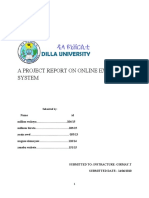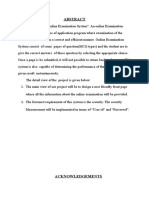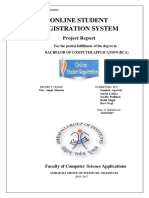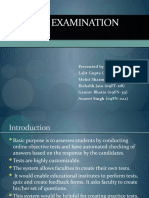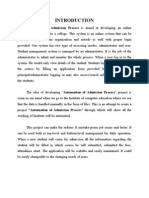73%(11)73% found this document useful (11 votes)
19K viewsOnline Examination System (ERD & DFD)
Online Examination System (ERD & DFD)
Uploaded by
BenLongkumerThe document discusses the project life cycle for an online examination system. It describes entity-relationship (ER) modeling which involves defining entities and relationships for a database. An ER diagram is presented for the online examination system. Data flow diagrams (DFDs) are also discussed as a way to visually represent the flow of data through a system. DFDs at different levels are presented, including context, level 1, and level 2 diagrams for various processes in the online examination system.
Copyright:
© All Rights Reserved
Available Formats
Download as DOCX, PDF, TXT or read online from Scribd
Online Examination System (ERD & DFD)
Online Examination System (ERD & DFD)
Uploaded by
BenLongkumer73%(11)73% found this document useful (11 votes)
19K views9 pagesThe document discusses the project life cycle for an online examination system. It describes entity-relationship (ER) modeling which involves defining entities and relationships for a database. An ER diagram is presented for the online examination system. Data flow diagrams (DFDs) are also discussed as a way to visually represent the flow of data through a system. DFDs at different levels are presented, including context, level 1, and level 2 diagrams for various processes in the online examination system.
Original Description:
Project life cycle
Original Title
Online Examination System(ERD & DFD)
Copyright
© © All Rights Reserved
Available Formats
DOCX, PDF, TXT or read online from Scribd
Share this document
Did you find this document useful?
Is this content inappropriate?
The document discusses the project life cycle for an online examination system. It describes entity-relationship (ER) modeling which involves defining entities and relationships for a database. An ER diagram is presented for the online examination system. Data flow diagrams (DFDs) are also discussed as a way to visually represent the flow of data through a system. DFDs at different levels are presented, including context, level 1, and level 2 diagrams for various processes in the online examination system.
Copyright:
© All Rights Reserved
Available Formats
Download as DOCX, PDF, TXT or read online from Scribd
Download as docx, pdf, or txt
73%(11)73% found this document useful (11 votes)
19K views9 pagesOnline Examination System (ERD & DFD)
Online Examination System (ERD & DFD)
Uploaded by
BenLongkumerThe document discusses the project life cycle for an online examination system. It describes entity-relationship (ER) modeling which involves defining entities and relationships for a database. An ER diagram is presented for the online examination system. Data flow diagrams (DFDs) are also discussed as a way to visually represent the flow of data through a system. DFDs at different levels are presented, including context, level 1, and level 2 diagrams for various processes in the online examination system.
Copyright:
© All Rights Reserved
Available Formats
Download as DOCX, PDF, TXT or read online from Scribd
Download as docx, pdf, or txt
You are on page 1of 9
At a glance
Powered by AI
The key takeaways are that an ER diagram models the entities and relationships of a database system and a DFD models the flow of data through a system and at different levels of detail.
An ER diagram (Entity Relationship diagram) is a conceptual data model that shows the relationships of entity sets (or object types) in an information system. It is used to interpret, specify and document requirements for databases irrespective of the database management system being used.
A DFD (Data Flow Diagram) is a graphical representation of the flow of data through an information system. It shows what data will be input and output from the system, where the data comes from and goes to, and where data is stored. A DFD is used to create an overview of a system that can later be elaborated on.
Online Examination System
9. Project Life Cycle (DFD & ERD)
9.1 ER Modeling
In software engineering, an entityrelationship model (ER model) is
a data model for describing the data or information aspects of a business
domain or its process requirements, in an abstract way that lends itself to
ultimately being implemented in a database such as a relational database. The
main components of ER models are entities (things) and the relationships that
can exist among them.
An Entity-relationship model (ERM) is an abstract and conceptual
representation of data. ER modeling is a DB modeling method, used to
produce a type of conceptual schema of a system. Diagrams created by this
process are called ER diagrams
Sequence: Conceptual data model (i.e. ER) is, at a later stage (called
logical design), mapped to a logical data model, (e.g. relational model); this
is mapped to a physical model in physical design. ER Model is used to
interpret, specify & document requirements for DBs irrespective of DBMS
being used.
The ER diagram of the project Online Examination System is shown
in Fig 9.1.
Online Examination System
Fig 9.1:- ER diagram for online examination system.
Online Examination System
9.2 Data Flow Diagram (DFD)
A data flow diagram (DFD) is a graphical representation of the "flow"
of data through an information system, modeling its process aspects. Often
they are a preliminary step used to create an overview of the system which
can later be elaborated. DFDs can also be used for the visualization of data
processing (structured design).
A DFD shows what kind of information will be input to and output
from the system, where the data will come from and go to, and where the data
will be stored. It does not show information about the timing of processes, or
information about whether processes will operate in sequence or in parallel.
Online Examination System
Fig 9.2:- Data Flow Diagram for online examination system.
Online Examination System
Fig 9.3:- Context diagram for online examination system.
Online Examination System
Fig 9.4:- Level 1 DFD for online examination system.
Online Examination System
Fig 9.5:- Level 2 DFD for process 2 (update subjects).
Online Examination System
Fig 9.6:- Level 2 DFD for process 3 (update questions).
Online Examination System
Fig 9.7:- Level 2 DFD for process 8 (exam process).
You might also like
- AVMS PPT JVGPBLDocument28 pagesAVMS PPT JVGPBLamareshwarbj infernapeNo ratings yet
- Online Examination - Project Report - Documentation OnlyDocument50 pagesOnline Examination - Project Report - Documentation OnlyArvind Singh82% (186)
- Online Exam System - Project ReportDocument40 pagesOnline Exam System - Project Reportmadhura089182% (28)
- Student Management System SRSDocument30 pagesStudent Management System SRSChandresh Prasad79% (53)
- Employee Management System SRSDocument29 pagesEmployee Management System SRSGaurav Kukreti68% (19)
- Perlove Products Detail InformationDocument10 pagesPerlove Products Detail Informationkrimo biomédicalNo ratings yet
- Online Examination SystemDocument36 pagesOnline Examination SystemSunil Mishra100% (1)
- SRS On Online Exam Registration SystemDocument30 pagesSRS On Online Exam Registration SystemKirupakaran Harikrishnan57% (14)
- University Management SystemDocument36 pagesUniversity Management SystemAmit Malhan50% (2)
- Student Staff Feedback System - Complete DocumentationDocument59 pagesStudent Staff Feedback System - Complete DocumentationSarath Kumar100% (1)
- Srs For Student Attandance Management SystemDocument7 pagesSrs For Student Attandance Management SystemRohini60% (5)
- Exam Registration SystemDocument12 pagesExam Registration SystemDeepak John61% (18)
- Online Examination SRSDocument10 pagesOnline Examination SRSVikas Sharma100% (1)
- Project For Online Examination SystemDocument47 pagesProject For Online Examination Systemyasin60% (5)
- Literature Survey of Online Examination SystemDocument1 pageLiterature Survey of Online Examination Systemengineeringwatch100% (4)
- Online Examination SystemDocument26 pagesOnline Examination SystemGeelani Snag0% (1)
- Online Examination System SynopsisDocument16 pagesOnline Examination System SynopsisAshish keer100% (2)
- Online Examination SystemDocument9 pagesOnline Examination SystemAbhi Sachan65% (20)
- Online Examination System ProjectDocument31 pagesOnline Examination System ProjectMohammed Sajeer79% (14)
- Online Examination Project Report Documentation OnlyDocument48 pagesOnline Examination Project Report Documentation OnlyPranav FirakeNo ratings yet
- DFD Placement CellDocument9 pagesDFD Placement CellSainath ParkarNo ratings yet
- Online ExaminationDocument67 pagesOnline ExaminationHIJITHMON78% (18)
- Online Examination System Project ReportDocument43 pagesOnline Examination System Project Reporthumnaharoon0% (1)
- Online Examination SystemDocument12 pagesOnline Examination SystemHarDeep KaurNo ratings yet
- College Stationery Management SystemDocument27 pagesCollege Stationery Management Systemtushars199460% (5)
- Online Course Register SystemDocument16 pagesOnline Course Register Systemsuriya extazeeNo ratings yet
- Project Report On Online ExaminationDocument28 pagesProject Report On Online Examinationdavidcoop025No ratings yet
- Examination Management System EditedDocument26 pagesExamination Management System EditedNitesh Kumar Tater80% (5)
- Employee Management Report-1Document14 pagesEmployee Management Report-1ShilpaNo ratings yet
- Se r18 Lab ManualDocument145 pagesSe r18 Lab Manualpradeeperukulla100% (2)
- Online Examination System - ProjectDocument13 pagesOnline Examination System - Projectshivashis198890% (10)
- University Admission SRS PDFDocument18 pagesUniversity Admission SRS PDFChinmay Mohanty100% (1)
- Online Examination SystemDocument123 pagesOnline Examination SystemJayank Chopra50% (4)
- Online Student Registration System: Project ReportDocument175 pagesOnline Student Registration System: Project ReportSanthu StràñgèrNo ratings yet
- Online Exam System (Shoyab Siddiquee) End Term Project ReportDocument28 pagesOnline Exam System (Shoyab Siddiquee) End Term Project Reportshoyab17100% (2)
- Online Exam SystemDocument41 pagesOnline Exam Systemsoumyabrata0100% (1)
- Placement Management SystemDocument50 pagesPlacement Management SystemSoubhhagya biswasNo ratings yet
- A Synopsis On "Resume Builder Web App": Submitted in Partial Fulfilment of The Requirements For BCA II YrDocument5 pagesA Synopsis On "Resume Builder Web App": Submitted in Partial Fulfilment of The Requirements For BCA II YrCatalyst GamingNo ratings yet
- Online Examination System, Use Case ProjectDocument32 pagesOnline Examination System, Use Case ProjectMohit Sharma100% (23)
- Online Examination Full ReportDocument119 pagesOnline Examination Full Reportjvdsyd100% (1)
- Placement Management SystemDocument25 pagesPlacement Management SystemKandarp DaVeNo ratings yet
- Automatic Timetable Generator Using PHP 1Document18 pagesAutomatic Timetable Generator Using PHP 1pooja.p100% (2)
- Online Examination System NewDocument72 pagesOnline Examination System Newshantilal33% (3)
- Admission Management SystemDocument40 pagesAdmission Management Systemravisayyes100% (2)
- Online Notice Board: Project Report For Bachelor of Computer ApplicationDocument30 pagesOnline Notice Board: Project Report For Bachelor of Computer ApplicationAnUp KaSuLaNo ratings yet
- Project On Student Management SystemDocument59 pagesProject On Student Management SystemAnuj Singh67% (3)
- Placement Information SystemDocument50 pagesPlacement Information SystemNagarjuna Reddy55% (20)
- School Fees System AbstractDocument3 pagesSchool Fees System AbstractRIYA MATENo ratings yet
- Online Examination System ERD DFDDocument9 pagesOnline Examination System ERD DFDA ARNo ratings yet
- Online Examination System ERD DFDDocument9 pagesOnline Examination System ERD DFDABHIJEET KUMARNo ratings yet
- Documents - Tips Online Examination Systemerd DFDDocument9 pagesDocuments - Tips Online Examination Systemerd DFDMøstaFa RäğäbNo ratings yet
- Practical 6Document5 pagesPractical 6Naimish SorathiyaNo ratings yet
- Ehr DiagramsDocument16 pagesEhr Diagramsmadhan_M46No ratings yet
- DFD and JSCDocument21 pagesDFD and JSCniharastha23No ratings yet
- Data Flow DiagramDocument4 pagesData Flow DiagramArun Shankar N. PillaiNo ratings yet
- 3.1overview of Sa/Sd MethodologyDocument33 pages3.1overview of Sa/Sd Methodologylew hooyyeNo ratings yet
- Chapter 4 Software Analysis and Design ToolsDocument19 pagesChapter 4 Software Analysis and Design ToolsMK MillyNo ratings yet
- Requirements AnalysisDocument23 pagesRequirements Analysisamanningombam5No ratings yet
- Analysis Concepts and PrinciplesDocument40 pagesAnalysis Concepts and PrinciplesMansi AgrawalNo ratings yet
- Imp DFDDocument44 pagesImp DFDTista BhaduriNo ratings yet
- Week 4 - ERD Model - An OverviewDocument26 pagesWeek 4 - ERD Model - An Overviewjamesawo688No ratings yet
- 9618 Practical Test Instructions June 2022Document4 pages9618 Practical Test Instructions June 20221752002sfNo ratings yet
- UiPath Certified RPA Associate v1.0 - EXAM DescriptionDocument7 pagesUiPath Certified RPA Associate v1.0 - EXAM DescriptionSea HawkNo ratings yet
- Gautam Updated FrontDocument3 pagesGautam Updated FrontNayan SahuNo ratings yet
- Esx Server: Netqueue Api 1.3Document20 pagesEsx Server: Netqueue Api 1.3ramu_scribdNo ratings yet
- Huawei Ale-L23c212b180 Upgrade Guideline v1.0Document7 pagesHuawei Ale-L23c212b180 Upgrade Guideline v1.0Johnatan Flores Reyes100% (1)
- Synopsis of Drowsiness Detection SystemDocument4 pagesSynopsis of Drowsiness Detection Systemmovies downloaderNo ratings yet
- SQA PreparationDocument4 pagesSQA PreparationRasedulIslamNo ratings yet
- Wireless Competitive Comparison: Cisco HPE HuaweiDocument6 pagesWireless Competitive Comparison: Cisco HPE Huaweimaster2tdNo ratings yet
- MODULE 4 - Digital ElectronicsDocument45 pagesMODULE 4 - Digital ElectronicsArun A100% (1)
- Cs116-REVISION Questions - Done By:Mr. Mustafa Radaideh - Final RevisionsDocument6 pagesCs116-REVISION Questions - Done By:Mr. Mustafa Radaideh - Final RevisionsMustafa RadaidehNo ratings yet
- Css QBDocument2 pagesCss QB14 - Prasad Bhot100% (1)
- M.Ferdian Ardhana - 4.2.8 Lab - Configure Router-on-a-Stick Inter-VLAN RoutingDocument10 pagesM.Ferdian Ardhana - 4.2.8 Lab - Configure Router-on-a-Stick Inter-VLAN RoutingImam SwinarnoNo ratings yet
- Laboratory 12 Digital Filter Designing Using Matlab Tools: ObjectivesDocument13 pagesLaboratory 12 Digital Filter Designing Using Matlab Tools: ObjectivesFaraz AbbasNo ratings yet
- Verification: "Are We Building The Product Right?"Document14 pagesVerification: "Are We Building The Product Right?"Rajesh YeluguruNo ratings yet
- Lesson Plan Name of The Subject Analog CommunicationsDocument4 pagesLesson Plan Name of The Subject Analog Communicationsyisakabera123No ratings yet
- SE II Accent System Installation and ConfigurationDocument69 pagesSE II Accent System Installation and Configurationcabunga2014No ratings yet
- NGN-B-EN-NGN Overview-1-PPT-201006Document28 pagesNGN-B-EN-NGN Overview-1-PPT-201006kmalNo ratings yet
- Getting Started With OAuth 2Document2 pagesGetting Started With OAuth 2Luigi AlcabeluNo ratings yet
- Unit 2Document8 pagesUnit 2Ansuman SamalNo ratings yet
- Principles of Programming Languages Full NoteDocument139 pagesPrinciples of Programming Languages Full Notefrancjohny100% (3)
- Encapsulation GRP No 8Document14 pagesEncapsulation GRP No 8pawarabhijeetNo ratings yet
- DTC300 Impresoras Fargo HID Mexico EspecificacionesDocument1 pageDTC300 Impresoras Fargo HID Mexico EspecificacionesCesar Coronado RamirezNo ratings yet
- Run The System File Checker ToolDocument5 pagesRun The System File Checker ToolBojan JerotijevićNo ratings yet
- C Programming LabDocument13 pagesC Programming LabGanesh KumarNo ratings yet
- Amalgamador LM1237Document42 pagesAmalgamador LM1237valam ltdaNo ratings yet
- MCQ CDocument10 pagesMCQ CMANOJ KUMAR D SNo ratings yet
- IOT and Embedded SystemsDocument2 pagesIOT and Embedded Systemspierre abreu mackleineNo ratings yet
- Brosur Zebra ZD510-HCDocument4 pagesBrosur Zebra ZD510-HCSinggih WidodoNo ratings yet
- PES University, BengaluruDocument8 pagesPES University, Bengalurusnigenigmatic972No ratings yet













